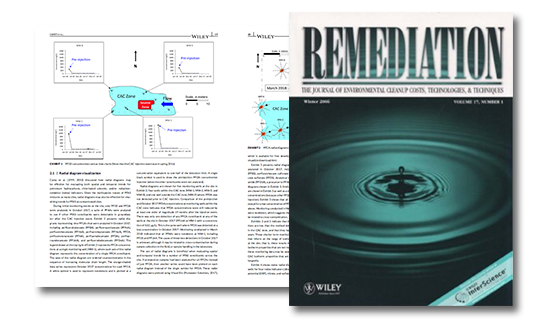Download the research article: Evaluating the Longevity of a PFAS In Situ Colloidal Activated Carbon Remedy
Background
The remediation of per- and polyfluoroalkyl substances by injection of colloidal activated carbon (CAC) at a contaminated site in Central Canada was evaluated using various visualization and modeling methods. Radial diagrams were used to illustrate spatial and temporal trends in perfluoroalkyl acid (PFAA) concentrations, as well as various redox indicators. To assess the CAC adsorption capacity for perfluorooctane sulfonate (PFOS), laboratory Freundlich isotherms were derived for PFOS mixed with CAC in two solutions: (1) PFOS in a pH 7.5 synthetic water that was buffered by 1 millimolar NaHCO3 (Kf = 142,800 mg1-a La/kg and a = 0.59); and (2) a groundwater sample (pH = 7.4) containing PFOS among other PFAS from a former fire-training area in the United States (Kf = 4,900 mg1-a La/kg and a = 0.24). A mass balance approach was derived to facilitate the numerical modeling of mass redistribution after CAC injection, when mass transitions from a two-phase system (aqueous and sorbed to organic matter) to a three-phase system that also includes mass sorbed to CAC. An equilibrium mixing model of mass accumulation over time was developed using a finite-difference solution and was verified by intermodel comparison for prediction of CAC longevity in the center of a source area. A three-dimensional reactive transport model (ISR-MT3DMS) was used to indicate that the CAC remedy implemented at the site is likely to be effective for PFOS remediation. Model results are used to recommend remedial design and monitoring alternatives that account for the uncertainty in long-term performance predictions.

 Americas
Americas Europe
Europe Français
Français Deutsch
Deutsch Italiano
Italiano Español
Español




